Verdict
In many respects, the HW-Q600C is just what the market is asking for. Reasonably priced, well-equipped and with some real positives where performance is concerned, it’s a fairly robust alternative to the default Sony and Sonos alternatives. But it would be more robust still if it wasn’t for one (fairly major) shortcoming…
Pros
- Expansive, detailed and full-range sound
- Nicely built and finished
- Handy dimensions will suit smaller TVs and smaller rooms
Cons
- Not the most pronounced spatial audio effect
- Sounds a bit lost when playing music
- No Dolby Vision HDR passthrough
-
Immersive audioDolby Atmos and DTS:X audio support -
Q SymphonyCombines soundbar speakers with Samsung TV speakers for bigger sound -
Adaptive SoundOptimises the soundbar performance for whatever programming you’re watching
Introduction
Now that it’s a common feature of smartphones, it seems safe to say Dolby Atmos is everywhere. The place where it’s most useful, though, is still in your front room as a part of your home cinema system.
Samsung is not the only company to offer cinema-style spatial audio from a modestly priced soundbar, of course – but with this HW-Q600C, it wants to be your go-to rather than just a vague option…
Availability
The Samsung HW-Q600C is on sale in the United Kingdom for £549. In the United States you should consider $599 the maximum you should spend, while in Australia you shouldn’t go above AU$799.
Just as with every other audio product featured on this website, the Samsung HW-Q600C has some obvious rivals, both where price and specification are concerned – the Sony HT-G700 and the (admittedly subwoofer-less) Bose Smart Soundbar 600 spring to mind. So it’s probably just as well that the Samsung’s pricing is so fluid…
Design
- Discreet proportions
- Soundbar + subwoofer = 11.7kg
- Almost exactly the width of your average 48-inch TV
It doesn’t do to play fast and loose with the design of a soundbar, of course – mostly certainly not when you’re competing in a part of the market that’s easily described as mainstream. And so Samsung has done the sensible thing, and not messed with the established design template in the slightest.
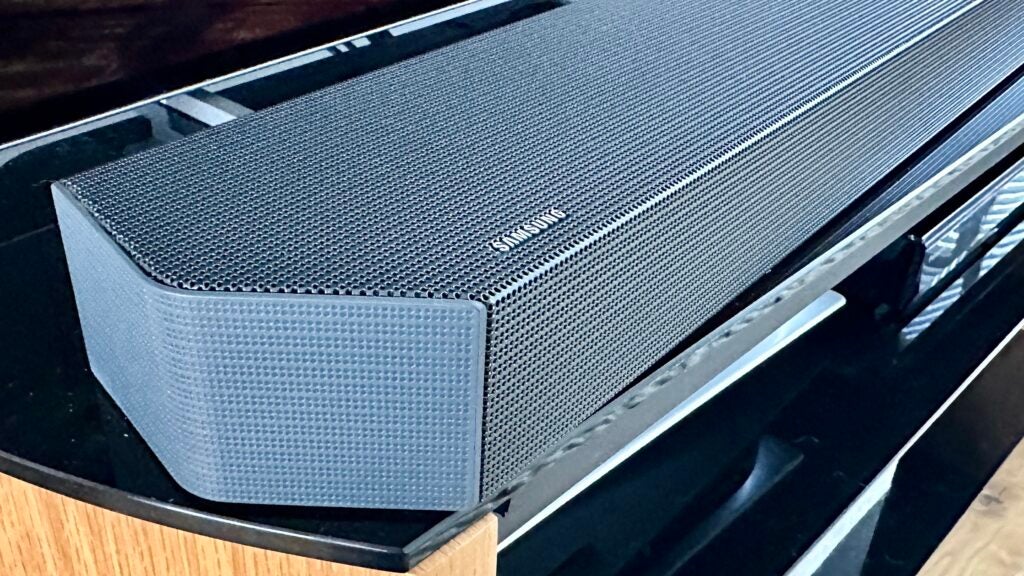
Both the soundbar and the subwoofer are of discreetly unremarkable proportions. At 343 x 184 x 295mm (HxWxD) the subwoofer certainly isn’t going to draw attention to itself – and the fact that it communicates wirelessly with the soundbar means it can be put more-or-less anywhere you like (as long as it’s within reach of mains power, of course). As you might imagine, it’s made of unremarkable materials – but as is equally predictable, it’s put together with obvious care and efficiency.
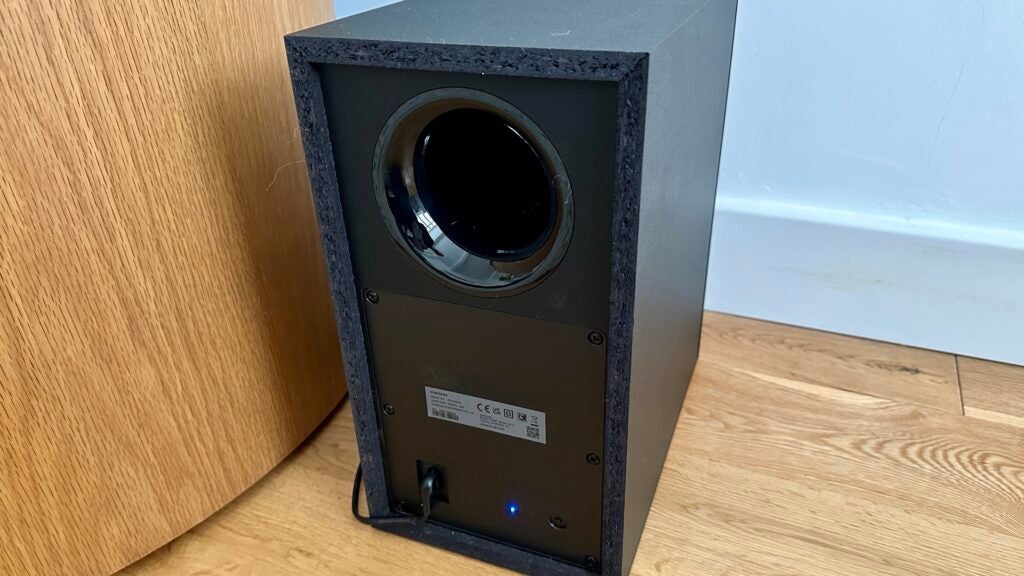
The soundbar, meanwhile, is an equally tidy 56 x 1030 x 105mm (HxWxD) – which means it’s almost the exact width of the average AV rack and won’t look overgrown accompanying a TV of, say, 48-inch or thereabouts. It’s mostly built of plastic – but it’s hard-wearing and actually quite tactile plastic, and everything is put together properly. Don’t be fooled by those angled ends, though – as the Features section will explain, there are no side-firing drivers here…
Features
- 3.1.2-channel layout
- 360 watts of Class D power in total
- 165mm forward-facing driver in the subwoofer
For reasons best known to itself, Samsung is keeping a few details of the HW-Q600C’s specification to itself. So here’s what I know, and also what Samsung doesn’t want me to know.
The HW-Q600C is arranged in a 3.1.2-channel layout. Obviously, the subwoofer takes care of the ‘.1’ part – it’s got a 165mm driver behind the acoustic cloth on the front of its vinyl-wrapped MDF cabinet and a bass reflex port at the back in order to generate the low-frequency stuff. The ‘3.2’ bit is the responsibility of the soundbar.
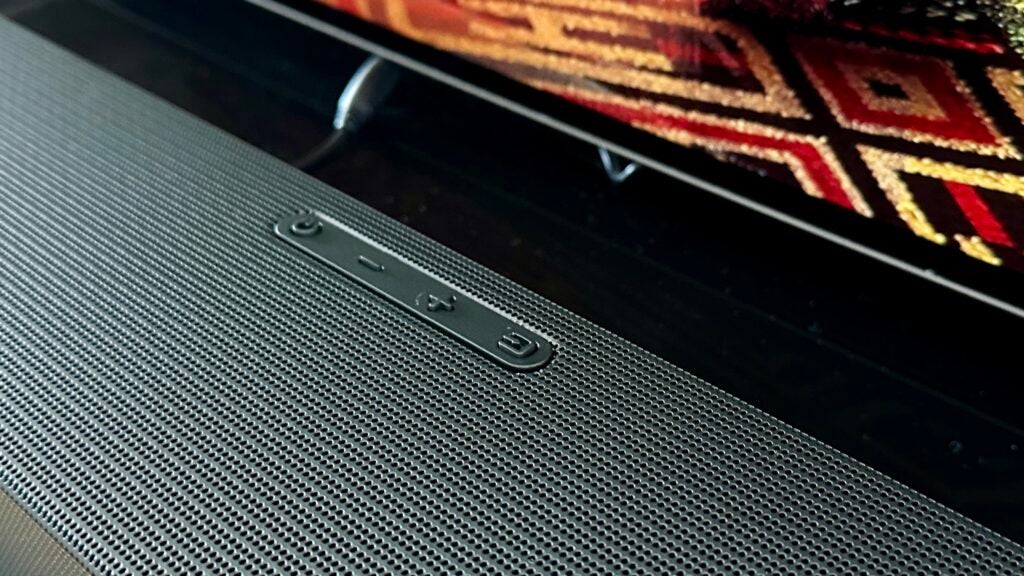
The soundbar has a total of nine drivers. I don’t know what type they are, how big they are or what they’re made of, but there are definitely nine. Three at each end make up the left and right channels, while a single driver in the centre of the front of the chassis deals, unsurprisingly, with the centre channel information.
Two more drivers face upwards and, via Samsung’s Acoustic Beam technology, attempt to create that sensation of sonic height that’s the whole point of Dolby Atmos and DTS:X soundtracks. Some of these drivers are just about visible through the perforated plastic that covers the front and top surfaces of the soundbar.
At its rear, the soundbar has two recesses for its physical connectivity. One has a socket for mains power and a USB slot that’s used only for servicing, while the other has a pair of HDMI sockets (on eARC-enabled) and a digital optical input. This means 4K passthrough is possible, which will be useful for some customers – but Samsung’s ongoing weirdness means it’s possible to passthrough HDR10+ HDR content but not Dolby Vision HDR. Like I say: weird. Wireless connectivity is limited to Bluetooth 5.0 with SBC and AAC codec compatibility.
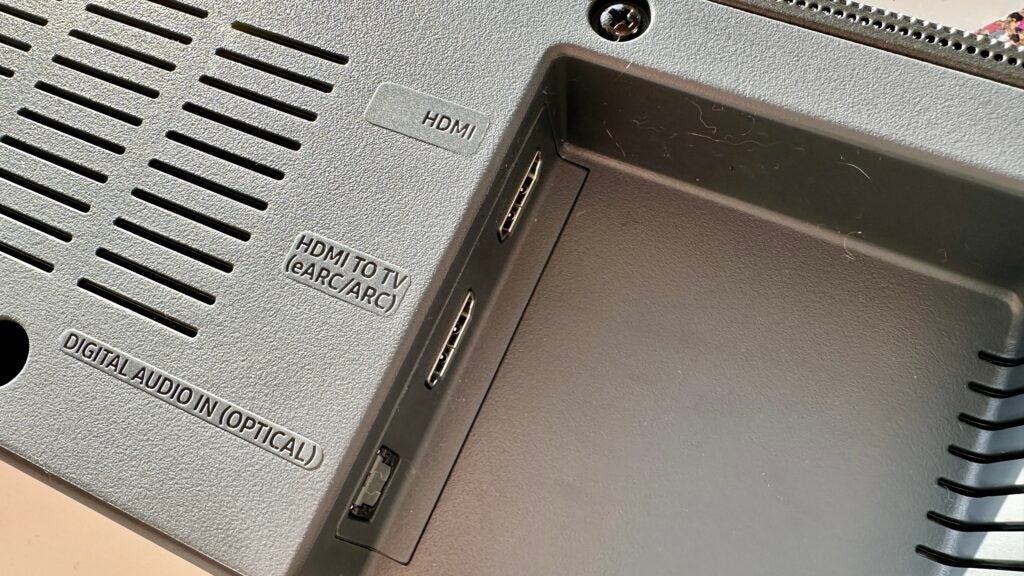
The HW-Q600C is a Q Symphony-compatible product. This means that if it’s paired with an appropriate Samsung television, the TV’s speakers can bolster the HW-Q600C’s efforts rather than be defeated by the presence of the audio system.
The system itself has four sound modes: Standard, Surround, Game Pro and Adaptive. Adaptive mode means the Samsung is assessing the content you’re watching in real time, and attempting to optimise its output to suit.
Controlling the system can be done in one of a few ways. There are physical controls allowing you to adjust volume, select input and power up or down on the top of the soundbar, and the HW-Q600C ships with a remote-control handset too. It’s not much to look at (or to hold, to be quite honest), but it gets the job done.
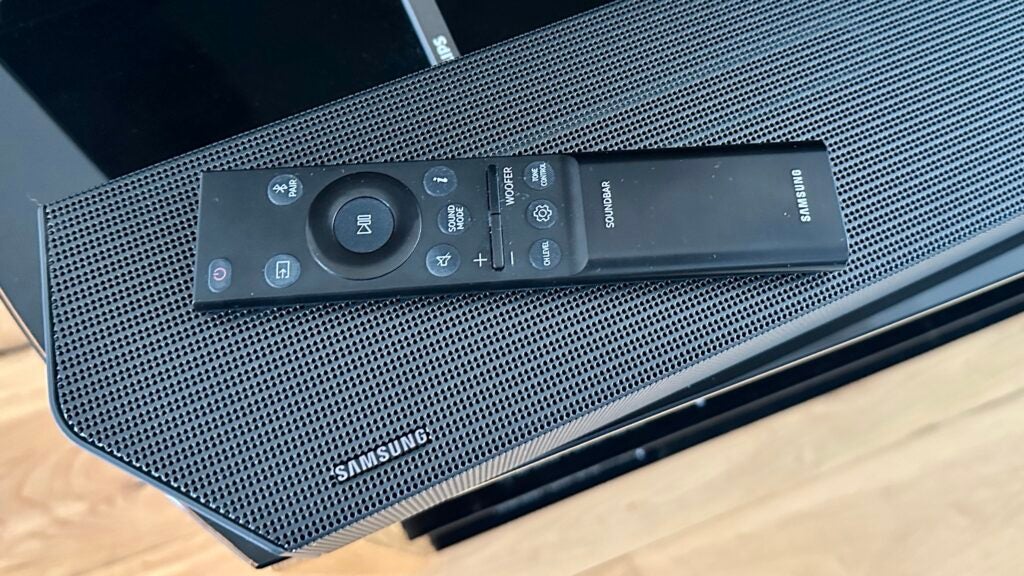
There’s no control app available, though – and if you want to use voice control, you’d better a) have an Amazon Alexa speaker to hand, and b) have plenty of time to put in trying to wrangle the Alexa and Samsung SmartThings apps. There’s an extremely small and indistinct display on the right of the soundbar’s front face, that lets you know what’s what. In theory, anyhow…
Sound Quality
- Organised, detailed and full-range sound
- Good presence and control from the subwoofer
- Sound is wide but not especially tall
When I’m testing Dolby Atmos-enabled products of any type, I find I consistently refer to the soundtrack to the UHD 4K Blu-ray of No Time To Die – for no other reason than it’s an absolute barnstormer that gives something like the HW-Q600C nowhere to hide.
The most immediately impressive aspect of the Samsung’s performance is just how balanced and convincingly neutral its tonality is. From the bottom of the frequency range to the top, its response is naturalistic and even – or, at least, it is once you’ve knocked some volume off the subwoofer’s factory settings. Once that’s done, the handover between sub and bar is nice and smooth.
Where the left/right and front/back aspects of the soundstage are concerned, the Samsung is a bigger listen than its dimensions suggest is possible. The stage is properly organised, easy to understand and remains controlled even when the action is all kicking off – effects are steered with positivity, and the centre channel is always positioned ahead of and distinct from the rest of the activity.
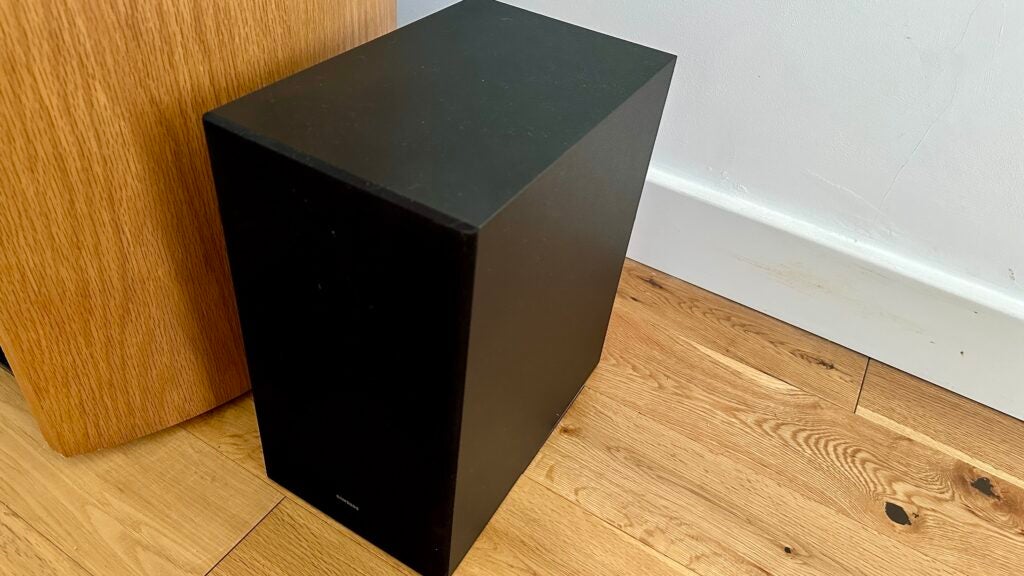
The subwoofer provides deep, controlled and properly textured foundations, and the leading edges of its contributions are always straight and well-defined. It hits hard but offers a fair amount of variation – and carries a gratifying amount of detail along with its considerable punch.
Detail levels are high across the board, in fact – and despite not being certain there are any tweeters in the soundbar, treble response is crisp and assertive. It’s the midrange, though – packed with information, and able to project ahead to keep dialogue coherent – that’s probably the most impressive. Especially when you consider the centre-channel is outnumbered, in terms of drivers, by the left and right channels either side of it.
There’s decent dynamic headroom available, so the numerous shifts in the soundtrack from tense near-silence to effects and orchestra overload are given good expression. Where shock and awe is concerned, the HW-Q600C has what it takes to make you sit up straight.
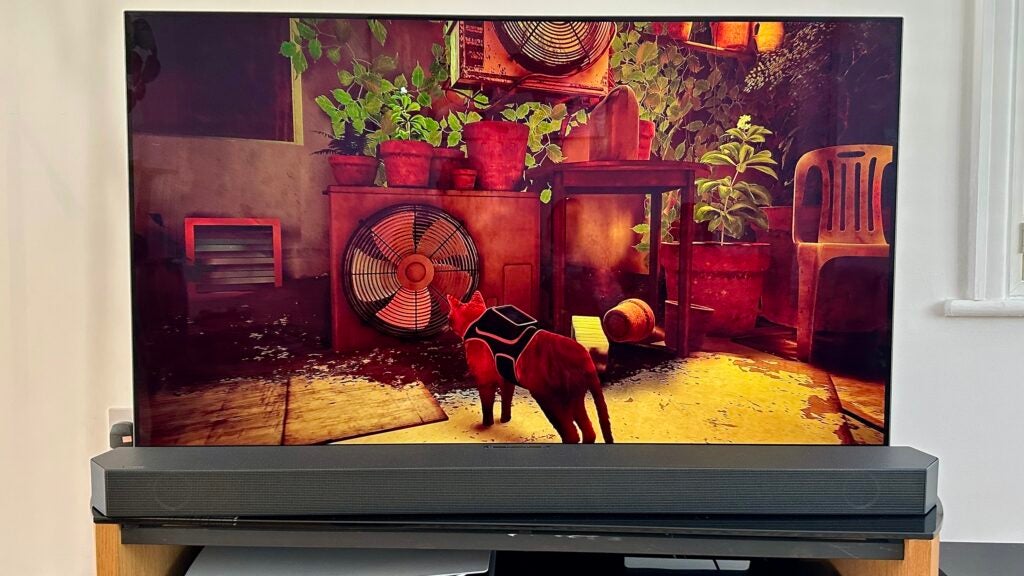
What it doesn’t have quite so much of, though, is a sensation of height to its presentation. The overhead aspect of the soundtrack is, at best, alluded to rather than made explicit – and as a consequence, the spatial part of this spatial audio soundtrack is rather understated. The sound the Samsung serves up is far wider and deeper than it is tall.
Switch to a two-channel digital audio file of Spiritualized’s Songs in A & E via Bluetooth and quite a bit of the system’s confidence deserts it. The lowest frequencies tend towards the monotonal, and this slight lumpiness makes rhythms sound a little stilted. If you’re after a do-it-all system for music as well as movie sound, the HW-Q600C might come up fractionally short.
Latest deals
Should you buy it?
You have a compact Samsung TV of the appropriate type
The Q Symphony feature is always worthwhile, and the HW-Q600C’s dimensions are more manageable than many alternatives.
You’re expecting to be immersed in your spatial audio soundtracks
The sonic height this system can generate is, to put it kindly, modest.
Final Thoughts
The problem is that when consumers see the words Dolby Atmos in a soundbar’s specification, their expectations are heightened accordingly. The HW-Q600C is just the latest Atmos soundbar I’ve tested that doesn’t make all that good on its spatial audio promises…
How we test
We test every soundbar system we review thoroughly over an extended period of time. We use industry standard tests to compare features properly. We’ll always tell you what we find. We never, ever, accept money to review a product.
Find out more about how we test in our ethics policy.
Tested with real world use
FAQs
The Samsung HW-Q600C soundbar supports 3.1.2 channels of sound. That means it has three front firing channels, a subwoofer, and two upfiring speakers for immersive audio.
Verdict
In many respects, the HW-Q600C is just what the market is asking for. Reasonably priced, well-equipped and with some real positives where performance is concerned, it’s a fairly robust alternative to the default Sony and Sonos alternatives. But it would be more robust still if it wasn’t for one (fairly major) shortcoming…
Pros
- Expansive, detailed and full-range sound
- Nicely built and finished
- Handy dimensions will suit smaller TVs and smaller rooms
Cons
- Not the most pronounced spatial audio effect
- Sounds a bit lost when playing music
- No Dolby Vision HDR passthrough
-
Immersive audioDolby Atmos and DTS:X audio support -
Q SymphonyCombines soundbar speakers with Samsung TV speakers for bigger sound -
Adaptive SoundOptimises the soundbar performance for whatever programming you’re watching
Introduction
Now that it’s a common feature of smartphones, it seems safe to say Dolby Atmos is everywhere. The place where it’s most useful, though, is still in your front room as a part of your home cinema system.
Samsung is not the only company to offer cinema-style spatial audio from a modestly priced soundbar, of course – but with this HW-Q600C, it wants to be your go-to rather than just a vague option…
Availability
The Samsung HW-Q600C is on sale in the United Kingdom for £549. In the United States you should consider $599 the maximum you should spend, while in Australia you shouldn’t go above AU$799.
Just as with every other audio product featured on this website, the Samsung HW-Q600C has some obvious rivals, both where price and specification are concerned – the Sony HT-G700 and the (admittedly subwoofer-less) Bose Smart Soundbar 600 spring to mind. So it’s probably just as well that the Samsung’s pricing is so fluid…
Design
- Discreet proportions
- Soundbar + subwoofer = 11.7kg
- Almost exactly the width of your average 48-inch TV
It doesn’t do to play fast and loose with the design of a soundbar, of course – mostly certainly not when you’re competing in a part of the market that’s easily described as mainstream. And so Samsung has done the sensible thing, and not messed with the established design template in the slightest.

Both the soundbar and the subwoofer are of discreetly unremarkable proportions. At 343 x 184 x 295mm (HxWxD) the subwoofer certainly isn’t going to draw attention to itself – and the fact that it communicates wirelessly with the soundbar means it can be put more-or-less anywhere you like (as long as it’s within reach of mains power, of course). As you might imagine, it’s made of unremarkable materials – but as is equally predictable, it’s put together with obvious care and efficiency.

The soundbar, meanwhile, is an equally tidy 56 x 1030 x 105mm (HxWxD) – which means it’s almost the exact width of the average AV rack and won’t look overgrown accompanying a TV of, say, 48-inch or thereabouts. It’s mostly built of plastic – but it’s hard-wearing and actually quite tactile plastic, and everything is put together properly. Don’t be fooled by those angled ends, though – as the Features section will explain, there are no side-firing drivers here…
Features
- 3.1.2-channel layout
- 360 watts of Class D power in total
- 165mm forward-facing driver in the subwoofer
For reasons best known to itself, Samsung is keeping a few details of the HW-Q600C’s specification to itself. So here’s what I know, and also what Samsung doesn’t want me to know.
The HW-Q600C is arranged in a 3.1.2-channel layout. Obviously, the subwoofer takes care of the ‘.1’ part – it’s got a 165mm driver behind the acoustic cloth on the front of its vinyl-wrapped MDF cabinet and a bass reflex port at the back in order to generate the low-frequency stuff. The ‘3.2’ bit is the responsibility of the soundbar.

The soundbar has a total of nine drivers. I don’t know what type they are, how big they are or what they’re made of, but there are definitely nine. Three at each end make up the left and right channels, while a single driver in the centre of the front of the chassis deals, unsurprisingly, with the centre channel information.
Two more drivers face upwards and, via Samsung’s Acoustic Beam technology, attempt to create that sensation of sonic height that’s the whole point of Dolby Atmos and DTS:X soundtracks. Some of these drivers are just about visible through the perforated plastic that covers the front and top surfaces of the soundbar.
At its rear, the soundbar has two recesses for its physical connectivity. One has a socket for mains power and a USB slot that’s used only for servicing, while the other has a pair of HDMI sockets (on eARC-enabled) and a digital optical input. This means 4K passthrough is possible, which will be useful for some customers – but Samsung’s ongoing weirdness means it’s possible to passthrough HDR10+ HDR content but not Dolby Vision HDR. Like I say: weird. Wireless connectivity is limited to Bluetooth 5.0 with SBC and AAC codec compatibility.

The HW-Q600C is a Q Symphony-compatible product. This means that if it’s paired with an appropriate Samsung television, the TV’s speakers can bolster the HW-Q600C’s efforts rather than be defeated by the presence of the audio system.
The system itself has four sound modes: Standard, Surround, Game Pro and Adaptive. Adaptive mode means the Samsung is assessing the content you’re watching in real time, and attempting to optimise its output to suit.
Controlling the system can be done in one of a few ways. There are physical controls allowing you to adjust volume, select input and power up or down on the top of the soundbar, and the HW-Q600C ships with a remote-control handset too. It’s not much to look at (or to hold, to be quite honest), but it gets the job done.

There’s no control app available, though – and if you want to use voice control, you’d better a) have an Amazon Alexa speaker to hand, and b) have plenty of time to put in trying to wrangle the Alexa and Samsung SmartThings apps. There’s an extremely small and indistinct display on the right of the soundbar’s front face, that lets you know what’s what. In theory, anyhow…
Sound Quality
- Organised, detailed and full-range sound
- Good presence and control from the subwoofer
- Sound is wide but not especially tall
When I’m testing Dolby Atmos-enabled products of any type, I find I consistently refer to the soundtrack to the UHD 4K Blu-ray of No Time To Die – for no other reason than it’s an absolute barnstormer that gives something like the HW-Q600C nowhere to hide.
The most immediately impressive aspect of the Samsung’s performance is just how balanced and convincingly neutral its tonality is. From the bottom of the frequency range to the top, its response is naturalistic and even – or, at least, it is once you’ve knocked some volume off the subwoofer’s factory settings. Once that’s done, the handover between sub and bar is nice and smooth.
Where the left/right and front/back aspects of the soundstage are concerned, the Samsung is a bigger listen than its dimensions suggest is possible. The stage is properly organised, easy to understand and remains controlled even when the action is all kicking off – effects are steered with positivity, and the centre channel is always positioned ahead of and distinct from the rest of the activity.

The subwoofer provides deep, controlled and properly textured foundations, and the leading edges of its contributions are always straight and well-defined. It hits hard but offers a fair amount of variation – and carries a gratifying amount of detail along with its considerable punch.
Detail levels are high across the board, in fact – and despite not being certain there are any tweeters in the soundbar, treble response is crisp and assertive. It’s the midrange, though – packed with information, and able to project ahead to keep dialogue coherent – that’s probably the most impressive. Especially when you consider the centre-channel is outnumbered, in terms of drivers, by the left and right channels either side of it.
There’s decent dynamic headroom available, so the numerous shifts in the soundtrack from tense near-silence to effects and orchestra overload are given good expression. Where shock and awe is concerned, the HW-Q600C has what it takes to make you sit up straight.

What it doesn’t have quite so much of, though, is a sensation of height to its presentation. The overhead aspect of the soundtrack is, at best, alluded to rather than made explicit – and as a consequence, the spatial part of this spatial audio soundtrack is rather understated. The sound the Samsung serves up is far wider and deeper than it is tall.
Switch to a two-channel digital audio file of Spiritualized’s Songs in A & E via Bluetooth and quite a bit of the system’s confidence deserts it. The lowest frequencies tend towards the monotonal, and this slight lumpiness makes rhythms sound a little stilted. If you’re after a do-it-all system for music as well as movie sound, the HW-Q600C might come up fractionally short.
Latest deals
Should you buy it?
You have a compact Samsung TV of the appropriate type
The Q Symphony feature is always worthwhile, and the HW-Q600C’s dimensions are more manageable than many alternatives.
You’re expecting to be immersed in your spatial audio soundtracks
The sonic height this system can generate is, to put it kindly, modest.
Final Thoughts
The problem is that when consumers see the words Dolby Atmos in a soundbar’s specification, their expectations are heightened accordingly. The HW-Q600C is just the latest Atmos soundbar I’ve tested that doesn’t make all that good on its spatial audio promises…
How we test
We test every soundbar system we review thoroughly over an extended period of time. We use industry standard tests to compare features properly. We’ll always tell you what we find. We never, ever, accept money to review a product.
Find out more about how we test in our ethics policy.
Tested with real world use
FAQs
The Samsung HW-Q600C soundbar supports 3.1.2 channels of sound. That means it has three front firing channels, a subwoofer, and two upfiring speakers for immersive audio.
























